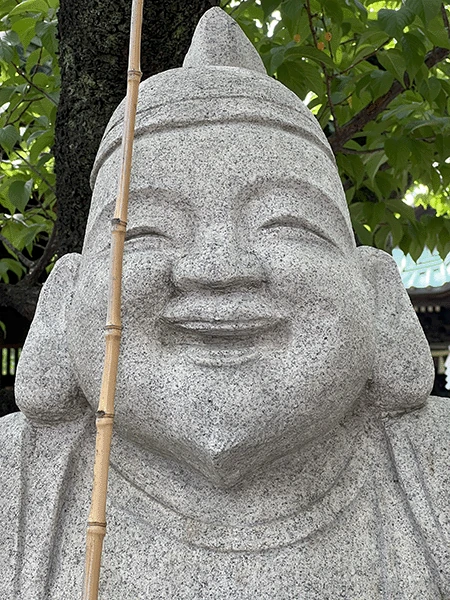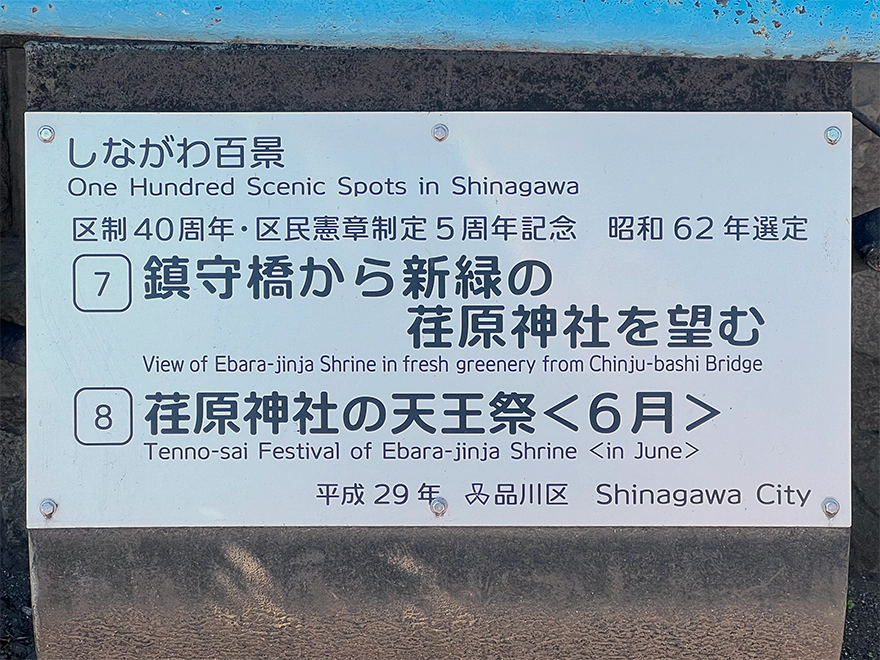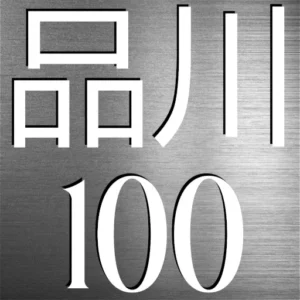🌿 Ebara-jinja – An Ancient Shrine Rooted in Water
Ebara-jinja (荏原神社) is one of Shinagawa’s oldest shrines, said to date back to 709 CE. The main deity is Takeminakata-no-Mikoto, linked to water, protection, and seafaring. For centuries, this shrine protected travelers heading to sea from Shinagawa’s historic ports.
The shrine enshrines several deities including the high god Okami-kami (Ryū-jin): 高龍神 (龍神), also known as the Dragon King who is considered the guardian deity of rainmaking and rain-stopping. Other deities enshrined include Amaterasu Ōkami: 天照皇大神, Susano-o-no mikoto: 須佐男之神, Toyōuke-hime-no-mikoto: 豊受姫之命 and Tachigarao-no-kami: 手力雄之神).
Ebara-jinja was historically significant to Ebara-gun. Ebara-gun was former administrative district comprising areas like Shinagawa, Ōta, Meguro, and Setagaya. Importantly, it was the Dragon guardian of Shinagawa and received support from the Genji, Tokugawa, Uesugi, and other Samurai families. (Ebara-gun as a formal province disappeared in 1932 with the creation of Greater Tokyo.)
While small in scale, Ebara-jinja holds major spiritual weight in the ward. It’s one of the seven Ebara Shichifukujin pilgrimage shrines and hosts an annual Funatogyo ritual. That is when sacred offerings are carried through Tokyo Bay by boat.
The Ebara shrine (荏原神社) founded in the year 709 (Wadō 2) and has had The current shrine building was completed in 1844 (Kōka 1).
Ebara-jinja’s Summer Festival
The Tenno-Sai festival happens early June. In the festival the participants carry a mikoshi (portable shrine) bearing the divine mask of Susanoo-no-Mikoto across the sea. This grand event is also known as the “Kappa Festival”.
Tokai Seven Lucky Gods: The shrine also enshrines one of the Tokai Seven Lucky Gods, Ebisu.

🌀 When the Meguro River Changed Course
Once a vital waterway closely tied to Ebara-jinja, the Meguro River no longer flows beside the shrine. This change was the result of gradual redirection and canalization projects during Tokyo’s urban expansion.
| Period | Development |
|---|---|
| Edo Period (1603–1868) | The river still flowed near Ebara-jinja. The shrine was spiritually and ritually tied to it, especially for the Funatogyo procession. |
| Meiji Era (1868–1912) | Urban engineering and modernization efforts gradually redirected sections of the river. Canalization increased. |
| Early 20th Century | By around 1910, the Meguro River had been straightened and shifted away from the shrine. Chinju Bridge spans a later canal. |
Unlike today the Meguro River flowed north of Ebara Shrine from the late Meiji to early Taisho period. The Meguro River was remodeled resulting in it flowing on the south side of the Ebara Shrine grounds. Because it was no longer possible to reach to Minami-Shinagawa by land, the Chinju-bashi Bridge 鎮守橋 was built in 1928 (Showa 3) as a path to the shrine from Minami-Shinagawa.
Today, visitors can still sense the old connection from Chinju Bridge, where the river’s modern course provides a peaceful reflective surface for Ebara-jinja’s seasonal greenery.
🌉 Chinju Bridge – “Guardian Deity Bridge” of Ebara-jinja
Chinju Bridge (鎮守橋) spans a the Meguro River just in front of Ebara-jinja. Its name — meaning “guardian deity bridge” — reflects the shrine’s presence at the water’s edge. This spot was chosen for the Hyakkei not because of size or height, but for perspective: looking across the canal, the green canopy of the shrine rises over the water like a natural sanctuary.
In late spring and early summer, the trees around the shrine explode in shades of green. It’s a fleeting moment of peace in a neighborhood of traffic and trains — best appreciated from the middle of this quiet bridge.
However, the red Chinju-bashi bridge over the Meguro River is more than mere river crossing. The term 鎮守橋 is composed of two parts: “鎮守” and “橋”. “鎮守” (Chinju) in Japanese refers to a deity or spirit that protects a specific area, region, or building. It’s often used in the context of Shinto shrines where the local deity is referred to as the “鎮守の神” (Chinju no Kami). “橋” (Hashi) translates to “bridge” in English. So, “鎮守橋” could be interpreted as “Guardian Deity Bridge” or “Protector’s Bridge”, signifying a bridge that’s under the protection or guardianship of a local deity. A common naming convention for bridges near Shinto shrines in Japan.
🌳 Greenery at Ebara-jinja
The shrine grounds are shaded by camphor, zelkova, and maple trees — some quite old. New growth in early May transforms the whole site into a soft emerald glow. This lush foliage plays a key role in Ebara-jinja’s photogenic calm, contrasting beautifully with the water, stone lanterns, and vermilion torii.
🌀 Shrine Details
- Enshrined Deity: Takeminakata-no-Mikoto (建御名方命) — god of water, wind, and fishing
- Affiliation: Shinto – Independent
- Founded: 709 CE (traditionally)
- Annual Events: Spring Festival, Summer Funatogyo, Shichifukujin Pilgrimage
Though modest, the shrine plays a large role in local heritage and marine protection rituals. Its connection to Shinagawa’s past as a coastal and fishing hub makes it spiritually rich.
📜 Name Timeline of Ebara-jinja
Ebara-jinja has had several names over the centuries, reflecting its evolving role in the Shinagawa region and changes in national religious policy.
| Imperial Era | Gregorian Date | Name (Kanji) | Name (Romaji) |
|---|---|---|---|
| Wadō 2 (和銅2年) | Sep 9, 709 | 貴布禰大明神 | Kibune Daimyōjin |
| Mid Heian period | 9th–10th century | 天王社 | Tennōsha |
| Late Edo period | By 1861 | 貴布禰神社 | Kibune Jinja |
| Meiji 1 (明治元年) | 1868 | 荏原神社 | Ebara-jinja |
The Meiji-era renaming aligned the shrine with Japan’s modern administrative districts and separated it from Buddhist-linked nomenclature under the new State Shinto system.
📍 Visitor Information
Address: 2-30-28 Kitashinagawa, Shinagawa-ku, Tokyo 140-0001
Access:
Shinbanba Station (Keikyū Main Line)
Kitashinagawa Station (Keikyū Line)
Best time to visit: Late April to early June for the full green effect
Admission: Free
Official Site
Where is it?
| what3words | ///shopping.downward.petted |
| latitude longitude | 35.6179177 139.7379243 |
| Nearest station(s) | Shinbamba Station (Keikyu Line) |
| Nearest public conveniences | Cross the river south, then go east and they’re just by Shinshinagawa Bridge. Or go to Shinbamba Station. |
Show me a sign.

No complaints about this sign.
Withervee says…
The bridge needs a lick of paint but atmosphere on the day was nice. The shrine is covered in greenery.
Ebara Shrine is the guardian shrine of South Shinagawa (Minami Shinagawa). Whereas Shinagawa Shrine is the guardian shrine of North Shinagawa (Kita Shinagawa).
Site Character
- Lifestyle 生活 (Seikatsu): ✔️
- Historical Significance 歴史 (Rekishi): ✔️
- Atmosphere/Natural Features 風土 (Fūdo): ✔️
Who in their right mind would vote for this?
- Local (Shinto) believers
- Bridge gazers
- Spring foliage chasers
- Shichifukujin pilgrims
- Photographers of quiet beauty
Further reading on Ebara-jinja
Rod’s Shinto Page on Ebara-jinja

